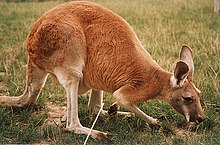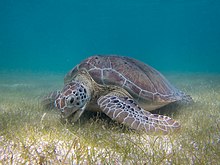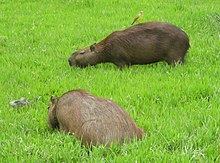Grazing (behaviour)

Grazing is a method of feeding in which a herbivore feeds on low-growing plants such as grasses or other multicellular organisms, such as algae. Many species of animals can be said to be grazers, from large animals such as hippopotamuses to small aquatic snails. Grazing behaviour is a type of feeding strategy within the ecology of a species. Specific grazing strategies include graminivory (eating grasses); coprophagy (producing part-digested pellets which are reingested); pseudoruminant (having a multi-chambered stomach but not chewing the cud); and grazing on plants other than grass, such as on marine algae.
Grazing's ecological effects can include redistributing nutrients, keeping grasslands open or favouring a particular species over another.
Ecology[edit]

Many small selective herbivores follow larger grazers which skim off the highest, tough growth of grasses, exposing tender shoots. For terrestrial animals, grazing is normally distinguished from browsing in that grazing is eating grass or forbs, whereas browsing is eating woody twigs and leaves from trees and shrubs.[1] Grazing differs from predation because the organism being grazed upon may not be killed. It differs from parasitism because the two organisms live together in a constant state of physical externality (i.e. low intimacy).[2][page needed] Water animals that feed by rasping algae and other micro-organisms from stones are called grazers–scrapers.[3]
Graminivory[edit]
Graminivory is a form of grazing involving feeding primarily on grass[4] (specifically "true" grasses in the Poaceae). Horses, cattle, capybara, hippopotamuses, grasshoppers, geese, and giant pandas are graminivores. Giant pandas (Ailuropoda melanoleuca) are obligate bamboo grazers, 99% of their diet consisting of sub-alpine bamboo species.[5]
Cecotrophy[edit]

For lagomorphs (rabbits, hares, pikas), easily digestible food is processed in the gastrointestinal tract & expelled as regular feces. But in order to get nutrients out of hard to digest fiber, lagomorphs ferment fiber in the cecum (in the GI tract) and then expel the contents as cecotropes, which are reingested (cecotrophy). The cecotropes are then absorbed in the small intestine to utilize the nutrients. This is a different process than cows chewing the cud, but with similar results.[6]
Capybara (Hydrochoerus hydrochaeris) are herbivores that graze mainly on grasses and aquatic plants,[7][8] as well as fruit and tree bark.[9] As with other grazers, they can be very selective,[10] feeding on the leaves of one species and disregarding other species surrounding it. They eat a greater variety of plants during the dry season, as fewer plants are available. While they eat grass during the wet season, they have to switch to more abundant reeds during the dry season.[11] The capybara's jaw hinge is not perpendicular; hence, it chews food by grinding back-and-forth rather than side-to-side.[12]
Like lagomorphs, capybara create, expel & eat cecotropes (cecotrophy) to get more nutrition from their food. They may also regurgitate food to masticate again, similar to cud-chewing by a cow.[13] As with other rodents, the front teeth of capybara grow continually to compensate for the constant wear from eating grasses.[14] Their cheek teeth also grow continuously.[12]
Pseudoruminant[edit]
The hippopotamus is a large, semi-aquatic, mammal inhabiting rivers, lakes and mangrove swamps. During the day, they remain cool by staying in the water or mud; reproduction and childbirth both occur in water. They emerge at dusk to graze on grasses. While hippopotamuses rest near each other in the water, grazing is a solitary activity. Their incisors can be as long as 40 cm (16 in) and the canines (tusks) up to 50 cm (20 in);[15] however, the canines and incisors are used for combat, and play no role in feeding. Hippos rely on their broad, horny lips to grasp and pull grasses which are then ground by the molars.[16] The hippo is considered to be a pseudoruminant; it has a complex three- or four-chambered stomach but does not "chew cud".[17]
Non-grass grazing[edit]
Although grazing is typically associated with mammals feeding on grasslands, ecologists sometimes use the word in a broader sense, to include any organism that feeds on any other species without ending the life of the prey organism.[18] Use of the term "grazing" varies further; for example, a marine biologist may describe herbivorous sea urchins that feed on kelp as grazers, even when they kill the organism by cutting the plant at the base. Malacologists sometimes apply the word to aquatic snails that feed by consuming the microscopic film of algae, diatoms and detritus—a biofilm—that covers the substrate and other surfaces underwater.[citation needed] In marine ecosystems, grazing by mesograzers such as some crustaceans maintains habitat structure by preventing algal overgrowth, especially in coral reefs.[19]
Benefits[edit]
Environmental[edit]

Grazer urine and feces "recycle nitrogen, phosphorus, potassium and other plant nutrients and return them to the soil".[20] Grazing can allow for the accumulation of organic matter which may help to combat soil erosion.[21] This acts as nutrition for insects and organisms found within the soil. These organisms "aid in carbon sequestration and water filtration".[20]
Biodiversity[edit]
When grass is grazed, dead litter grass is reduced which is advantageous for birds such as waterfowl.[22] Grazing can increase biodiversity. Without grazing, many of the same grasses grow, for example brome and bluegrass, consequently producing a monoculture.
In North American tallgrass prairies, diversity and productivity are controlled to a large extent by nitrogen availability ... Nitrogen availability in prairies was driven by interactions between frequency of fires and grazing by large herbivores ... Spring fires enhance growth of certain grasses, and herbivores such as bison preferentially graze these grasses, keeping a system of checks and balances working properly, and allowing many plant species to flourish.[23]
References[edit]
- ^ "Browsing is a specialized form of grazing. "Graze, verb: 2. Eat growing grass." "Browse, verb: 1. Feed on, crop, (leaves, twigs, scanty vegetation)."". Concise Oxford Dictionary (6 ed.). 1976. ISBN 0-19-861122-6.
- ^ Stiling, Peter (1999). Ecology: theories and applications (3rd ed.). Upper Saddle River, NJ: Prentice Hall. ISBN 0139156534.
- ^ Begon, M.; Townsend C.; Harper, J. (1990). Ecology (2 ed.). Blackwell Science, London. ISBN 0-86542-111-0.
- ^ "Definition of GRAMINIVOROUS". www.merriam-webster.com.
- ^ ZHOU, Shiqiang; et al. (2012). "Effects of wildness training giant pandas? Grazing and artificial harvesting on clone population biomass of umbrella bamboo (Fargesia robusta)". Chinese Journal of Applied Environmental Biology. 18 (1): 1–8. doi:10.3724/sp.j.1145.2012.00001.
- ^ "Information for Rabbit Owners — Oak Tree Veterinary Centre". Oaktreevet.co.uk. Archived from the original on 2012-06-23. Retrieved 2010-08-30.
- ^ Capybara Facts. Smithsonian National Zoological Park. Retrieved on December 16, 2007.
- ^ Forero-Montana J, Betancur J, Cavelier J (2003). "Dieta del capibara Hydrochaeris hydrochaeris (cavia: Hydrochaeridae) en Caño Limón, Arauca, Colombia". Revista de Biología Tropical. 51 (2): 571–578. PMID 15162749. PDF
- ^ Capybara. Palm Beach Zoo. Retrieved on December 17, 2007.
- ^ Quintana, R.D., S. Monge, A.I. Malvárez (1998). "Feeding patterns of capybara Hydrochaeris hypdrochaeris (Rodentia, Hydrochaeridae) and cattle in the non-insular area of the Lower Delta of the Parana River, Argentina". Mammalia. 62 (1): 37–52. doi:10.1515/mamm.1998.62.1.37. S2CID 83976640.
{{cite journal}}: CS1 maint: multiple names: authors list (link) - ^ Barreto, Guillermo R.; Herrera, Emilio A. (1998). "Foraging patterns of capybaras in a seasonally flooded savanna of Venezuela". Journal of Tropical Ecology. 14 (1): 87–98. doi:10.1017/S0266467498000078. JSTOR 2559868. S2CID 84982123.
- ^ a b Capybara. Hydrochaeris hydrochaeris. San Francisco Zoo
- ^ Lord-Rexford, D. (1994). "A descriptive account of capybara behaviour". Studies on Neotropical Fauna and Environment. 29 (1): 11–22. doi:10.1080/01650529409360912.
- ^ Bristol Zoo Gardens (UK) Capybara Archived 2007-09-18 at the Wayback Machine. Bristolzoo.org.uk. Retrieved on 2011-12-07.
- ^ Estes, R. (1992). The Behavior Guide to African Mammals: Including Hoofed Mammals, Carnivores, Primates. University of California Press. pp. 222–26. ISBN 0-520-08085-8.
- ^ Kingdon, J. (1988). East African Mammals: An Atlas of Evolution in Africa, Volume 3, Part B: Large Mammals. University Of Chicago Press. pp. 256–77. ISBN 0-226-43722-1.
- ^ Eltringham, S.K. (1999). The Hippos. Poyser Natural History Series. Academic Press. ISBN 0-85661-131-X.
- ^ Begon, M., Townsend, C. and Harper, J. (1996). Ecology (3 ed.). Blackwell Science, London.
{{cite book}}: CS1 maint: multiple names: authors list (link)[page needed] - ^ Pearson, Ryan M.; Jinks, Kristin I.; Brown, Christopher J.; Schlacher, Thomas A.; Connolly, Rod M. (2018). "Functional changes in reef systems in warmer seas: Asymmetrical effects of altered grazing by a widespread crustacean mesograzer". Science of the Total Environment. 644: 976–981. Bibcode:2018ScTEn.644..976P. doi:10.1016/j.scitotenv.2018.07.051. hdl:10072/382266. ISSN 0048-9697. PMID 30743894. S2CID 53074768.
- ^ a b "Benefits of Grazing Cattle on the Prairie". Native Habitat Organization. Retrieved 1 Dec 2008 Archived 2007-03-06 at the Wayback Machine
- ^ Dalrymple, R.L.. "Fringe Benefits of Rotational Stocking". Intensive Grazing Benefits. Noble Foundation. Retrieved 1 Dec 2008 Archived 2008-08-20 at the Wayback Machine
- ^ "Waterfowl area grazing benefits birds, cattle - The Fergus Falls Daily Journal". 21 February 2008.
- ^ "Bison Grazing Increases Biodiversity In ...(Grazing by herbivorous mammals like b...)". news.bio-medicine.org.


 French
French Deutsch
Deutsch